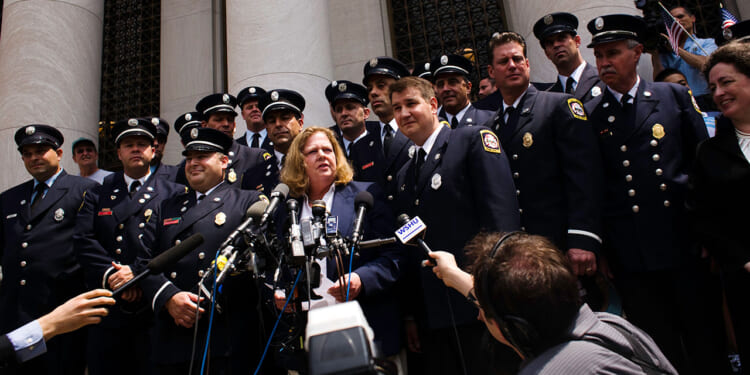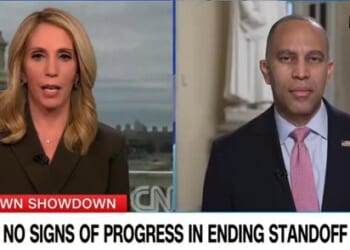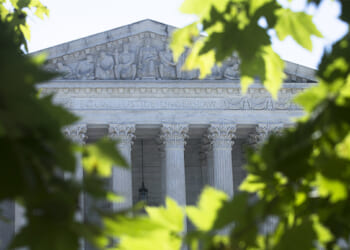In the Biden administration’s final year, the Department of Justice filed four lawsuits against local and state public-safety departments: the Maryland State Police; the fire departments of Durham, North Carolina, and Cobb County, Georgia; and the police department of South Bend, Indiana. In each case, the DOJ alleged that these agencies had used racially discriminatory written tests—citing disproportionate failure rates for black applicants and questioning whether the tests were sufficiently job-related. The DOJ also challenged the physical-fitness tests used by South Bend and Maryland, claiming that they unfairly screened out women, and objected to Cobb County’s past use of credit checks, which, it argued, had a racially disparate impact.
The complaints did not highlight concrete problems with the tests, but online, the popular X user “Crémieux” had a field day mocking the suits, posting lengthy threads of publicly available sample questions. As it turned out, the written exams tested basic math, reading, writing, and decision-making skills, with questions that were generally, if sometimes a bit artificially, set in relevant public-safety contexts.
One practice section of the National Police Officer Selection Test, at issue in the Maryland case, had applicants read four paragraphs about crime in libraries and answer simple questions, such as the true-or-false query “According to the passage, libraries in the United States do not experience very much theft or vandalism.” The practice exam for the Durham fire department’s test featured this brainteaser: “A firefighter determines that 350 feet of hose is needed to reach a particular building. If the hoses are 60 feet in length, what is the minimum number of lengths of hose needed?”
Some of the defendants were less amused. After all, they had been singled out from among tens of thousands of police and fire departments nationwide. In its public response, South Bend defended its practices, noting that its physical testing met the Indiana Law Enforcement Academy’s minimum standards, that it allowed applicants to attempt the test several times per hiring cycle—unlike other Indiana cities—and that its department had become increasingly diverse in recent years. The city also pointed out that it offers free tutoring for the written test, which it described as “similar to written tests in other Indiana police departments, including the Indiana State Police.” South Bend’s police chief added that he was “beyond disappointed that the DOJ has not been forthcoming with how these claims were determined in the first place.” Durham’s fire chief struck a similar note, telling local media that the department was “a little shocked” to learn that its validated, vetted test—developed by a company that produces exams for hundreds of fire departments—was suddenly no longer considered valid by the DOJ. He added that the department had received no explanation of which parts of the test were allegedly problematic.
All the targeted departments, except South Bend, agreed to consent decrees rather than fight the cases in court. But none of the agreements was finalized before Donald Trump returned to the White House, and all four suits were dropped in early 2025. Over the following months, the administration reinforced these moves: a memo from the attorney general and an executive order from the president instructed prosecutors to avoid bringing similar cases in the future. Meantime, new leadership at the DOJ’s Civil Rights Division oversaw what insiders described as a “bloodbath,” with numerous career staff members departing.
Still, these cases provide a window into “disparate impact,” a vague and unpredictable legal doctrine under which the good-faith use of a professionally developed test can land an employer in court—or not, depending on who controls the White House, whether a private party brings a claim, and how aggressively a court scrutinizes the test. The stakes are especially high in police and fire department hiring, where objective standards help prevent favoritism, physical and mental competence are essential, and placing the wrong person in a role can cost lives.
The story begins with the Civil Rights Act of 1964, one of America’s foundational antidiscrimination laws. The statute’s original text made no mention of disparate impact and explicitly protected employment tests—as long as they were professionally developed and not “designed, intended, or used” to discriminate based on illegitimate criteria such as race. At the time, deliberate use of tests to screen out black applicants, rather than to assess job-related skills, was a serious concern.
However, in a series of decisions beginning with 1971’s Griggs v. Duke Power, the Supreme Court ruled that professionally developed tests (and other selection mechanisms) could still be considered illegal discrimination, even without any intent to discriminate. Congress later codified this interpretation in the 1991 Civil Rights Act, explicitly authorizing the courts to apply the disparate-impact framework.
These cases typically unfold in three stages. First, the challenger must show that the test produces a disparate impact—that is, applicants from certain demographic groups pass at significantly lower rates than others. (A common, though nonbinding, guideline is the so-called 80 percent rule, which flags disparities when one group’s pass rate falls below 80 percent of another’s.) Given persistent racial gaps in academic performance, well-documented biological differences in physical strength, and cultural differences in interests, this first hurdle is often easily cleared. Law professor Gail Heriot has even offered $10,000 to anyone who can identify a hiring process completely free of disparate impact on any protected group.
At the second stage, the burden shifts to the employer to prove that the test is “job-related for the position in question and consistent with business necessity.” This is where things get extremely complicated and subjective. It’s not enough to show that the test was professionally developed and used in good faith and that it measured job-relevant skills or knowledge. Employers must navigate a maze of technical arguments in what often becomes a courtroom “battle of the experts.” Courts frequently look to the Equal Employment Opportunity Commission’s detailed Uniform Guidelines on Employee Selection Procedures as a benchmark, though these guidelines do not carry the force of law.
Where was the test developed, and how was it validated? If the test was developed by an outside vendor, how did employers verify its applicability to their own practices? If the test was validated by linking results to job performance, how strong was that correlation? If validated through a detailed analysis of job requirements, how comprehensively does the test cover the requirements? Is the employer using the test as just one factor in a broader evaluation, or is it screening out candidates below a specific cutoff score or ranking applicants by precise scores? What evidence supports the choice of cutoff, or the claim that a candidate who scores an 81 is truly more qualified than one who scores an 80? Federal intervention in local public-safety hiring can turn on how a court weighs technical flaws, value judgments, and trade-offs like these.
If the employer manages to get through that minefield, there’s a third stage. The challenger can still win by formulating an alternative selection mechanism that would serve the employer’s needs with less disparate impact.
Employers win many disparate-impact cases. But doing so can involve the expense of a trial, followed by the appeals process. To take one example: Erdman v. City of Madison involved a woman who—while successful in the Janesville, Wisconsin, fire department—was unable to get hired in Wisconsin’s capital. She failed Madison’s written exam in 2006, 2008, 2010, 2012, and 2018, but sued over her 2014 experience, when she passed the written test but failed the physical one. The suit, filed in 2016, went to trial in 2018. Four years later, a district judge ruled that the physical test—which included tasks like shuttling equipment, dragging a hose, and using a pike pole to breach a ceiling—was sufficiently job-related, even though it disproportionately screened out women. The judge also rejected claims that a different test would have been a better alternative. Last year, an appeals court upheld that ruling.
It’s also very possible for employers to lose a disparate-impact suit. For instance, Smith v. City of Boston, involving a police exam for promotion to lieutenant, went against the city. In a painfully detailed 2015 opinion, the district court found fault with numerous aspects of the test, including its emphasis on job knowledge (in contrast with skills and abilities, such as “interpersonal skills, presentation skills, reasoning and judgment skills”), as well as its use to rank-order candidates. After six more years of legal back-and-forth, Boston agreed to end its appeal.
Problems for the DOJ’s 2024 consent decrees began even before the Trump administration abandoned them.
The disparate-impact doctrine pressures employers to avoid hiring practices that produce uneven demographic results, if alternatives are available. But once a test has been administered, employers cannot simply discard the results because one group scored higher on average. According to the Supreme Court’s 2009 decision in Ricci v. DeStefano, doing so may amount to discrimination against the better-performing group, unless the employer has a “strong basis in evidence” to believe that it would face disparate-impact liability if it used the results.
But what happens if, instead of discarding the test on its own, the employer is sued by the DOJ, chooses not to fight, and agrees to offer preferential hiring or back pay to applicants from the lower-performing group? Two of the courts reviewing the 2024 consent decrees raised legal concerns about this approach, too.
In its agreement with the DOJ, Cobb County agreed to change its testing procedures, pay $750,000 to affected black applicants, and create up to 16 priority-hire positions for such applicants. But the court overseeing the case questioned the legality of this remedy, noting that it “is arguably a form of intentional discrimination based on race—only those claimants who are African American are entitled to seek relief.” Such a remedy might be permitted if it compensated for proven race-based discrimination. Yet the allegations had never been litigated, and the county explicitly denied wrongdoing, even while agreeing to the consent decree. The court therefore rejected the settlement, ruling that—even under pressure from the federal government—the county lacked the “strong basis in evidence” required by Ricci to justify race-conscious relief.
The judge in the Durham case requested briefing on the same questions: whether Ricci applied and whether Durham had met its standard. The Trump DOJ dropped the case before the issue was resolved, but the Biden DOJ’s earlier filing remains revealing: it clearly spelled out specific objections to the test. As expected, these objections focused on technical shortcomings, not on claims of bad faith or incompetence.
In its brief, citing the analysis of a paid expert, the Biden DOJ argued that Durham had failed to follow all the test developer’s recommendations, lacked a sufficient rationale for setting a 70 percent cutoff score and for using the test to rank candidates for interviews, and had relied on a test validated in the late 2000s without updating it through a local, current-day job analysis. The brief also claimed that the test was not fully “representative of the job of firefighter.”
The test developer, Fire and Police Selection, Inc., provided City Journal with a detailed defense of the test, noting that it had been designed through an extensive study of firefighting demands, in accordance with the Uniform Guidelines. The company emphasized that experts had reviewed every test item to ensure fairness and relevance, that more than 200 departments had adopted the test, and that it had offered to conduct a local validation study for Durham.
Of course, that still leaves an unsatisfying question. Countless police and fire departments across the country use arguably imperfect testing procedures that result in racial or gender disparities. How does the DOJ decide which departments to investigate and sue? Bob Scales, CEO of the consulting group Police Strategies, pointed out in an interview that the Civil Rights Division’s internal decision-making process has been opaque: “They don’t publish anything, so we don’t know the criteria that they use.”
The DOJ under both the Biden and Trump administrations declined to provide comment for this article. Each of the four jurisdictions involved declined to comment beyond their public statements or did not provide comment after multiple requests. But knowledgeable sources can shed light on the matter.
“It’s just a question of where DOJ is going to put its enforcement resources, what it’s going to choose to go after, and what cities it’s going to choose to go after,” said Joshua P. Thompson, director of equality and opportunity litigation at the Pacific Legal Foundation and coauthor of a law-review article on disparate impact. “That is completely at the whim of the Justice Department or the civil rights enforcement agencies.”
The staffing of the DOJ’s Civil Rights Division offers one clue and helps explain the new Trump administration’s eagerness to replace key personnel. A 2011 series of articles by Hans A. von Spakovsky, a Heritage Foundation senior legal fellow and former career attorney in the division, described how hiring under President Obama had heavily favored partisan Democrats and former employees of activist organizations.
Bradley J. Schlozman, acting assistant attorney general of the Civil Rights Division during the George W. Bush administration and now a partner at the Hinkle Law Firm, recalled that many cases originated with attorneys getting “tips from special-interest groups or left-liberal advocacy organizations with which they were affiliated and often had a prior employment relationship.” Smaller cases, he added, sometimes arose in more routine ways—through news reports or when career attorneys took a personal interest in their own hometown.
“If it’s not a high-profile incident, it might be an activist group or a local politician,” Scales said. “Maybe you’ll have a city council member who will write to the DOJ and say, ‘I think my police department’s racist,’ and they’ll come in and do an investigation. But it’s hard because there’s no documentation.”
Why don’t more cities fight? “Often you find cities that maybe want to impose race-conscious policies, and then the Biden administration comes knocking and gives them a pass to do that without having to worry about being sued over it,” Thompson said. The high cost and reputational risk of defending against a discrimination lawsuit—especially when facing a powerful opponent like the DOJ—are other strong incentives to settle rather than fight.
It’s hard for a department to avoid lawsuits and liability proactively, given the subjectivity involved both within the executive branch and in the courts. “The only way they are going to avoid trouble with a liberal Justice Department is if they ensure that at the end of the year, when you break down their hiring, it fits the racial quotas that the Justice Department thinks you ought to have,” von Spakovsky observed.
Needless to say, just as a left-leaning administration might pursue disparate-impact cases aggressively, a right-leaning one might take a far more skeptical approach. In fact, in an executive order issued in April, the Trump administration took the stance that disparate impact “all but requires individuals and businesses to consider race and engage in racial balancing to avoid potentially crippling legal liability,” running “contrary to equal protection under the law” and thus violating the Constitution. Under the order, federal agencies “shall deprioritize enforcement of all statutes and regulations to the extent they include disparate-impact liability” and should review any ongoing cases and consent decrees reliant on the theory.
This does not change the underlying law. Private parties may still sue public-safety departments and other employers for disparate-impact violations, and a future administration will be free to change course.

The disparate-impact legal doctrine has existed for more than half a century, yet police and fire departments continue to use written and physical tests—despite the legal risks—because these tests offer an objective way to ensure that employees have the skills that the job demands.
“We need to ensure that the firefighter has the physical ability to do the job. Nobody wants to be hanging out of a third-story window and have a firefighter who can’t carry or drag them out,” said Frank Ricci, a retired New Haven, Connecticut, fire battalion chief and the lead plaintiff in Ricci v. DeStefano. Ricci, now a labor fellow at the Yankee Institute and author of Command Presence, added: “Reading comprehension is critical. While we don’t tend to look things up in a book at a fire, you do have to consult manuals for hazardous materials incidents—and you also need to know essential information when you’re out at a fire and can’t look something up.”
These job requirements, of course, are no less critical for police. Jason C. Johnson, president of the Law Enforcement Legal Defense Fund, pointed out that the Biden administration itself pressured departments to adopt detailed policies and minimize the use of force. “But here you have a situation where a department is trying to recruit applicants who can read and understand written material,” he noted, “and who have the physical fitness to control individuals they are arresting or struggling with—without having to resort to deadly force. And then the same administration turns around and says, ‘No, no, you can’t do that,’ because of disparate impact.”
Today, the executive branch may be taking a dim view of disparate-impact cases, but achieving a lasting solution will require changes to the legal status quo—meaning action by Congress or the courts.
The most straightforward reform would be for Congress to eliminate liability for disparate impact in cases where there is no evidence of discriminatory intent. Less dramatically, Congress could adopt more employer-friendly standards for defending tests, preapprove a set of standardized exams for public-safety departments with clear usage guidelines, or establish a process allowing departments and test developers to submit tests for preapproval.
Courts could also strike down disparate impact as a violation of equal protection, adopting the argument advanced by the Trump administration and previously raised by the late Justice Antonin Scalia in his Ricci concurrence. Alternatively, they could narrow the doctrine in future rulings, though Congress’s decision to codify disparate impact in the statute presents a hurdle to that approach.
Either way, the status quo is untenable. Racial gaps in academic achievement begin long before hiring, and biological differences between men and women are real. (See “Sexual Politics.”) Mere disparity should not create the presumption of liability. More than 50 years after Griggs, reform is long overdue.
Fire battalion chief Frank Ricci, the lead plaintiff in a landmark disparate-impact case (Christopher Capozziello/The New York Times/Redux)


















